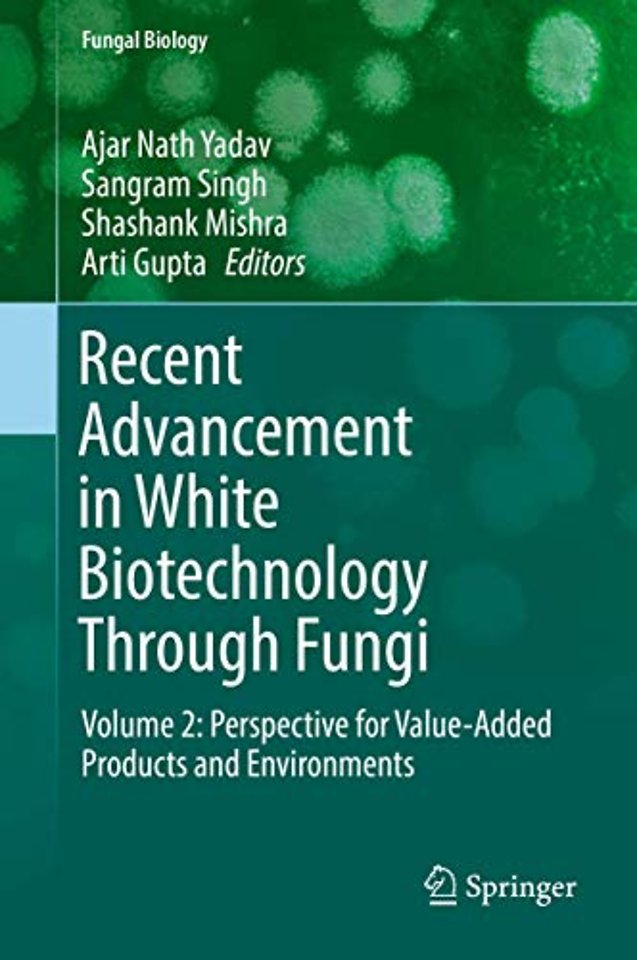Recent Advancement in White Biotechnology Through Fungi
Volume 2: Perspective for Value-Added Products and Environments
Samenvatting
White biotechnology is industrial biotechnology dealing with various biotech products through applications of microbes. The main application of white biotechnology is commercial production of various useful organic substances, such as acetic acid, citric acid, acetone, glycerine, etc., and antibiotics like penicillin, streptomycin, mitomycin, etc., and value added product through the use of microorganisms especially fungi and bacteria. The value-added products included bioactive compounds, secondary metabolites, pigments and industrially important enzymes for potential applications in agriculture, pharmaceuticals, medicine and allied sectors for human welfare. In the 21st century, techniques were developed to harness fungi to protect human health (through antibiotics, antimicrobial, immunosuppressive agents, value-added products etc.), which led to industrial scale production of enzymes, alkaloids, detergents, acids, biosurfactants. The first large-scale industrial applications of modern biotechnology have been made in the areas of food and animal feed production (agricultural/green biotechnology) and pharmaceuticals (medical/red biotechnology). In contrast, the production of bio-active compounds through fermentation or enzymatic conversion is known industrial or white biotechnology. The beneficial fungal strains may play important role in agriculture, industry and the medical sectors. The beneficial fungi play a significance role in plant growth promotion, and soil fertility using both, direct (solubilization of phosphorus, potassium and zinc; production of indole acetic acid, gibberellic acid, cytokinin and siderophores) and indirect (production of hydrolytic enzymes, siderophores, ammonia, hydrogen cyanides and antibiotics) mechanisms of plant growth promotion for sustainable agriculture. The fungal strains and their products (enzymes, bio-active compounds and secondary metabolites) are very useful for industry. The discovery of antibiotics is a milestone in the development of white biotechnology. Since then, white biotechnology has steadily developed and now plays a key role in several industrial sectors, providing both high valued nutraceuticals and pharmaceutical products. The fungal strains and bio-active compounds also play important role in the environmental cleaning. This volume covers the latest research developments related to value-added products in white biotechnology through fungi.
Specificaties
Inhoudsopgave
<p> Chapter 2 Industrially Important Pigments from Different Groups of Fungi</p>
<p>V.S. Chauhan, Bundelhkhand University, India</p>
<p>Chapter 3 Industrially Important Enzymes from Fungi for Food and Feed Processing</p>
<p>Suzymeire Baroni, Center for Health Sciences, Brazil</p>
<p>Chapter 4 Fungal Phytases: Biotechnological Application in Food and Feed</p>
<p>Vinod Kumar, Eternal University, India</p>
<p> Chapter 5 Research and Production of Natural Value-Added Compounds from Fungal Community</p>
<p>Mohammad Shahid, Soochow University, China </p>
<p>Chapter 6 Biotransformation of Agricultural Waste into Valuable Aroma-Compounds for Nutraceuticals</p>
<p>María Angeles Sanromán, Campus Universitario As Lagoas – Marcosende, E-36310 Vigo, Spain</p>
<p>Chapter 7 Natural Product Synthesis by Fungi: Recent Trends</p>
<p>Bijender Singh, MD University, India</p>
<p>Chapter 8 Biosynthesis of Methoxyphenol Aromas from Hydroxycinnamic Acid through Fungi</p>
<p>Nuansri Rakariyatham, Chiang Mai University, Chiang Mai 50200, Thailand</p>
<p>Chapter 9 Recent Advancements on the Role and Analysis of Volatile Compounds from Fungi</p>
<p>Paolina Garbeva, Netherlands Institute of Ecology,Netherlands</p>
<p>Chapter 10 Lignocellulosic Biomass Transformations: From Enzyme-Catalysis to Metabolic Engineering</p>
<p>Fabrizio Sibilla, Chemiepark Knapsack, Germany</p>
<p>Chapter 11 Bioconversion of Biomass to Biofuel using Fungal Consortium</p>
Jitendra Kumar Saini, Centre for Advanced Bio-Energy Research, India <p>Chapter 12 New Prospects of Bioremediation for Environmental Cleaning by Fungal Enzymes</p>
<p>Sudhir Shekhar, BBAU Central University Lucknow, India</p>
<p>Chapter 13 Fungal Enzyme System for Saccharification of Lignocellulosic Feedstocks</p>
<p>Zahid Anwar, University of Gujrat, Pakistan</p>
<p>Chapter 14 The Potential of White-Rot Fungi in the Treatment of Pollutants</p>
<p>Ernest Marco-Urrea, Universitat Auto`noma de Barcelona, 08193 Bellaterra, Barcelona, Spain</p>
Chapter 15 White-Rot Fungi and Their Enzymes for the Treatment of Industrial Dye Effluents <p>Manish Kumar, Amity University, India</p>
<p>Chapter 16 Fungal Secretomes: Biodegradation Lignocelluloses and Biopolymers</p>
<p>Holger Zorn , Technische Universität Dortmund Dortmund, Germany</p>
<p>Chapter 17 Bioremediation of Xenobiotic Compounds by the White-Rot Fungus</p>
<p>Showat Ahmad Alone, Jammu University, India</p>
<p>Chapter 18 Extracellular Fungal Peroxidases and Laccases for Waste Treatment: Recent Improvement</p>
I.D. Buchanan, University of Alberta, Canada. <p>Chapter 19 Implications of Fungal Enzymes for Bioremediation of Heavy Metals Contaminated Soil</p>
<p>Diby Paul, Konkuk University, Korea </p>
<p>Chapter 20 Current Challenges of Research on Fungi as Sustainable Bio-Economy</p>
<p>Vera Meyer, Berlin University of Technology, Germany</p>
<p>Appendixes</p><p>Index </p>

